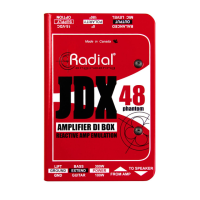1
DESIGN CONCEPT
The JDX 48 differs from a standard DI like the Radial J48. A standard DI
taps the output of the guitar before it is connected to an amplier. The JDX
48 taps the output of your amplier yielding a completely different sound.
The JDX 48 is placed between the amplier and loudspeaker. A proprietary
reactive circuit follows the constantly changing interaction between amp
and speaker to capture the dynamic response of your amp. Then an active
multi-stage lter processes the signal to emulate the frequency response
of a loudspeaker and nally, the JDX 48 uses a Class-A buffering amplier
to output a signal suitable for pro-recording and PA systems.
JDX 48 Amplier Direct Box vs. Standard Direct Box
Bass and acoustic guitars often use a standard DI to capture the clean
sound of the instrument. This works because these instruments almost
always use an unprocessed sound and the PA system merely amplies
the levels of the direct signal.
Electric guitars generally don’t use standard DIs because the amplier
and loudspeaker play an important part in a player’s sound. Typically a
microphone is used to capture the amplied guitar sound. This raises
several other variables such as bleed, placement and acoustics that come
along with using microphones.
JDX 48 Amplifier DiStAnDArD Di miXing ConSole
The Radial JDX 48 is inserted between the amplier and speaker cabinet
eliminating the microphone and delivering the sound of a player’s amp
directly to the recording or PA console. By removing the variables of a
microphone, the consistency of the sound from night to night is improved.
This is a boon to in-ear monitor users. When listening through in-ear
monitors subtle differences in mic placement and room acoustics can
translate into huge changes in tone. The JDX 48 provides great sound
while eliminating bleed from other instruments, like drums, from leaking
into the guitar mix.

